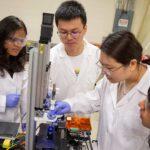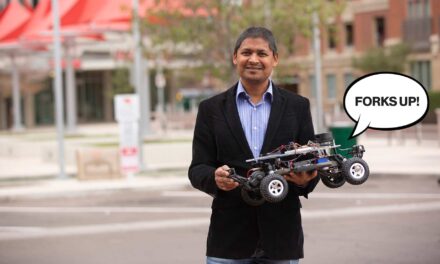
Plotting droplets: New mathematical tools for more robust simulations

Simulating a fluid spray, such as a sneeze, can prove to be a challenge especially when droplets are too small to be included in the simulation. Assistant Professor Mohamed Kasbaoui and Professor Marcus Herrmann are working on a numerical method that can improve these simulations to more accurately model fluid sprays. Photo courtesy of Pixabay
As we draw closer to cold and flu season — and with the heightened stress of a global pandemic — a sneeze that sends a blast of potentially infected droplets flying from a person’s mouth at nearly a hundred miles per hour is enough to make anyone nervous.
And sneezes, just like other fluid sprays, can be mathematically modeled.
ASU faculty members Mohamed Kasbaoui and Marcus Herrmann are collaborating on a National Science Foundation-funded project to develop and test new mathematical tools to ensure every droplet is accounted for in these simulations.
“We do computational fluid dynamics, which means we look at the motion of fluid flows and try to model that in computer simulations,” says Kasbaoui, an assistant professor of mechanical and aerospace engineering. “When you have multiple fluids, such as a liquid and a gas, running simulations often requires some additional methods that end up being quite expensive computationally. These require running simulations on supercomputers for many days.”
Kasbaoui and Herrmann have received a total of $300,000 to work on the three-year project starting this fall to develop algorithms to more efficiently model fluid sprays like sneezes at multiple resolutions as droplets break apart and travel from the source.
For example, in any fluid spray, a sheet of liquid initially comes from the source. Small droplets break off from that sheet as the fluid travels farther out from the source, and as the piece of liquid breaks down, these droplets become progressively smaller.
“These tiny droplets that detach often fall beneath the resolution of the simulation,” Kasbaoui says. “So, part of what we’re trying to do is see how we can also accurately model the fate of those small droplets.”
As these droplets detach and get increasingly smaller, they can become so small that it requires a prohibitive amount of computing power to simulate them. These simulations also are not always the most accurate.
“Right now in the simulations we do a transfer of droplets from large scale to small scale, but it’s very ad hoc,” says Herrmann, a professor of mechanical and aerospace engineering. “It’s not mathematically sound. With the sneezing, you know what happens with the droplets very close to the nose, but what is the eventual fate of these drops? Where do they travel? There’s a different mathematical way to simulate those, and we are trying to figure out how to couple these two in an accurate and efficient manner.”
Currently, there is a mathematical method of simulating the formation of droplets, and a mathematical method of simulating how a large piece of liquid breaks down into smaller droplets. However, these two methods cannot be used together as they are not compatible with one another because of discontinuities between the two methods.
“We’re trying to bridge this gap by coming up with a new mathematical foundation that allows us to derive a computational method out of it to implement it in large-scale simulations that we will be running on supercomputers,” Kasbaoui says.
These simulations can be used on more than just sneezes, however.
The new mathematical tools can be used “anywhere you have a spray,” Herrmann says. “Pharmaceutical sprays, nasal inhalers, misting systems, fuel injection systems, sneezing and coughing are all examples. It doesn’t have to be liquid and a gas, there can be solid particles as well, such as in a haboob or a dust storm. Anywhere you have small particles in a flow, we are looking to try to describe it.”
Because of the numerous areas in which this research can be applied, this project has the potential to impact a large number of industries.
“If we can come up with more efficient and higher fidelity numerical tools, engineers who design these systems, like the fuel sprays or nasal inhalers, can use these computational tools to better design these systems and implement them in factories,” Kasbaoui says. “Right now, they have to use empirical methods that are not really well suited if you’re going to change the design a lot. If you want to come up with a radically new design for the spray of your system, you’d better have high fidelity numerical methods to aid in those simulations.”
In addition to this research, Kasbaoui and Herrmann are also conducting outreach to help the general public learn about their work. They’ll be collaborating with Assistant Research Professor Brandon Mechtley from the School of Arts, Media and Engineering at ASU. Mechtley has a performing arts stage called the iStage that is equipped with motion-capture sensors and projectors that can help visualize their research.
“We can project simulations on this performing arts stage and participants can come up on the stage. As they walk around, they can interact with the simulation of the fluid flow around them,” Kasbaoui says. “We hope people can be inspired by this to pursue STEM education.”



































